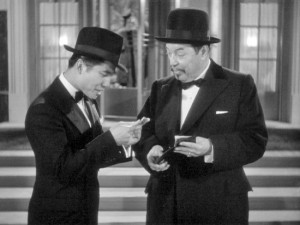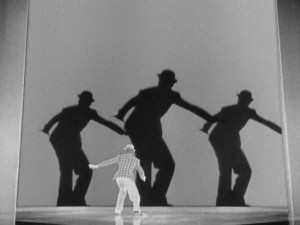Whitewash or Fair Use: Portraying Race on Film
/https://tf-cmsv2-smithsonianmag-media.s3.amazonaws.com/filer/20120518030035Dictator-thumb.jpg)
Over on the newly designed, buggy, and glacially slow Salon website, Daily Show correspondent Aasif Mandvi recently “channeled” a studio executive to address race in movies—specifically white actors playing non-white roles. It’s been a sore point in the film industry for over 100 years, one that deserves better than Mandvi’s take. The comic throws out a few smart-aleck remarks and a dozen or so flimsy but admittedly embarrassing examples, reaching back to 1937′s The Good Earth. But he ignored the more obvious examples practically staring him in the face—like The Dictator, the Sacha Baron Cohen comedy about the leader of the North African country “Wadiya.”
Based on a Pearl S. Buck novel, The Good Earth might appear racist today, but at the time it was considered an enlightened, sympathetic account of peasant life in China. Louise Rainer even won an Oscar for her portrayal of O-lan; like her costar Paul Muni and the rest of the Caucasian cast, she taped up her eyebrows to approximate an Asian appearance. Picking on The Good Earth for its largely progressive racial attitudes seems pretty silly, given that most Hollywood films at the time limited Asian roles to cooks, valets or villains like Fu Manchu.
And there are so many more relevant examples to choose from. Early film in particular is rife with examples of unapologetic racism. In Chinese Laundry Scene (1895), an Irish cop chases a Chinaman; both are depicted as buffoons. (The film starred the vaudeville team of Robetta and Doretto, so this could be the earliest example in movies of a white portraying a member of another race.) In A Morning Bath (1896), a “mammy” stereotype tries and fails to wash the color off a black infant’s skin. Watermelon Feast (1896), The Chicken Thief (1904), The Greaser’s Gauntlet (1908) and similar titles featured even cruder caricatures. Few films delivered as potent, or as damaging, an account of race than The Birth of a Nation (1915), a work that mixed African-American actors with whites wearing blackface.
Sacha Baron Cohen and Ben Kingsley in The Dictator, from Paramount Pictures. © 2012 Paramount Pictures. All Rights Reserved. Photo: Melinda Sue Gordon.
Early filmmakers treated Europeans with equal cruelty, as well as Southerners, New Englanders, Midwesterners, farmers, laborers, sales clerks, bankers, rubes, city slickers, women, children—you get the picture. In a sense filmmakers were simply reflecting the media around them. It was a time when minstrel shows were still touring the South, when singers like May Irwin and Nora Bayes were famous for “coon” songs, when the African-American star Bert Williams wore blackface on stage.
That doesn’t excuse the filmmakers, theatrical producers, songwriters and performers who took advantage of looser standards to belittle another race or culture; who typecast blacks, Mexicans, and Asians as servants, bandits, and all-purpose villains; who prohibited them from appearing on screen at all, replacing them with white actors. (Or, in an even weirder example of racism, ordered actress Fredi Washington to wear darker makeup so she wouldn’t be mistaken for a white woman in The Emperor Jones.)
The issue gets murkier with a character like Charlie Chan, who was based on the real-life Honolulu detective Chang Apana. In 2003, when the Fox Movie Channel started broadcasting the Chan films prior to releasing them on DVD, some Asian activists protested, objecting to both the way Chan’s character was written and the fact that he was portrayed by Caucasians (including the Swedish-born Warner Oland). (I haven’t found any protests against Manuel Arbó, who portrayed Chan in 1931′s Spanish-language Eran Trece.)
Chan—the smartest person in his films—was ultimately an empowering figure, and a good corrective to Sax Rohmer’s Fu Manchu, impersonated on screen by Boris Karloff, among others.
Artists always have a choice. I can’t recall a single instance of Charlie Chaplin using racial humor, but my favorite filmmaker, Buster Keaton, too often made blacks the brunt of jokes. Similarly, writer and director Preston Sturges liked making his black bartenders and butlers frightened and not especially bright (for example, Sullivan’s Travels, The Palm Beach Story), something his contemporary Val Lewton never did.
In his piece, Mandvi overlooked several of the more striking examples of whites playing other races. Al Jolson used blackface throughout his career, including his groundbreaking musical The Jazz Singer. Judy Garland and Mickey Rooney wore blackface in the musical Babes in Arms. These can be seen as attempts to appropriate black culture, and as such are uncomfortable to watch. But when Fred Astaire did an impersonation of Bill Robinson in Swing Time, it seemed like a genuine homage, an attempt to honor a respected fellow dancer.
Was it racist when Orson Welles donned dark makeup to play the lead in his screen adaptation of Shakespeare’s Othello (1952), or an artistic choice? When Laurence Olivier made his version of Othello in 1965, would it have been better received if he hadn’t gone to such extremes with his makeup?
So, yes, John Wayne played Genghis Khan in The Conqueror (1960), just like Chuck Connors played Geronimo (1962) and Jeff Chandler, Cochise in Broken Arrow (1950). But Wayne also played Swedish sailor Ole Olsen in John Ford’s adaptation of the Eugene O’Neill play The Long Voyage Home (1940)—arguably a tougher stretch for the Duke. Should filmmakers be given credit for treating these characters with respect? Is it worse when Tony Curtis impersonates the Pima Indian hero Ira Hayes (in The Outsider, 1961), or when he pretends to be a 15th-century knight (in The Black Shield of Falworth, 1954)?
Perhaps the real issue here isn’t whether Caucasians can portray different races, sexual orientations, or genders. What should bother us is if it is clear that the artist’s intention was to hurt. And this seems to be at the center of the Arab-American response to The Dictator.
Guessing the motives of artists is tricky work. In Borat, Sacha Baron Cohen mocks the people of Kazakhstan, portraying them as ignorant and perverted. But for many, Baron Cohen got away with his character because he also portrayed Americans in the film as ignorant and bigoted. When Baron Cohen mocked homosexuals in Bruno, the critical response was more muted.
Complaints against Baron Cohen started early on in The Dictator publicity campaign: Nadia Tonova, a director of the National Network for Arab American Communities; attorney Dean Obeidallah on CNN Opinion; writer Lucas Shaw on The Wrap.
Because his character in The Dictator is an evil fool, Baron Cohen again feels he has license to employ jokes that in other hands would be racist. New York Times critic A.O. Scott finds this logic “repellant” in his review. “We could laugh at his grossness, secure in the knowledge that we weren’t really xenophobic because we were also sneering at the fools falling for the trick,” Scott writes. “Dumb hicks. Dumb foreigners. Thank goodness we’re not bigots like them!”
Racism, closely linked to xenophobia, is inextricably laced into popular culture. In his Words and Places; or, Etymological Illustrations of history, ethnology and geography, Isaac Taylor listed the many ways the names used for different ethnic groups could be traced back to roots meaning “other,” “outsider,” “barbarian,” “enemy.” It’s when we intentionally limit our understanding of the peoples we don’t know, or insist on seeing them as “others,” that we become racist.
Read new Reel Culture postings every Wednesday and Friday. And you can follow me on Twitter @Film_Legacy.
/https://tf-cmsv2-smithsonianmag-media.s3.amazonaws.com/accounts/headshot/daniel-eagan-240.jpg)



/https://tf-cmsv2-smithsonianmag-media.s3.amazonaws.com/accounts/headshot/daniel-eagan-240.jpg)